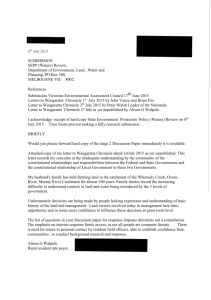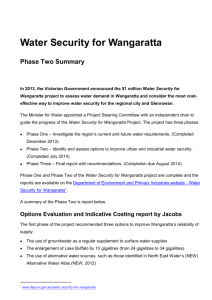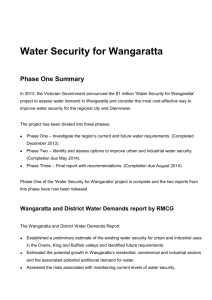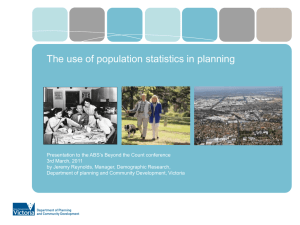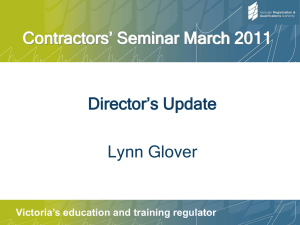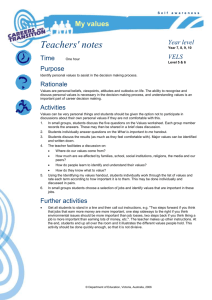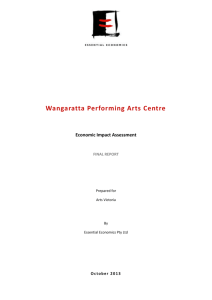Microsoft Word - Submission to DEDJTRs Regional Service Delivery
advertisement
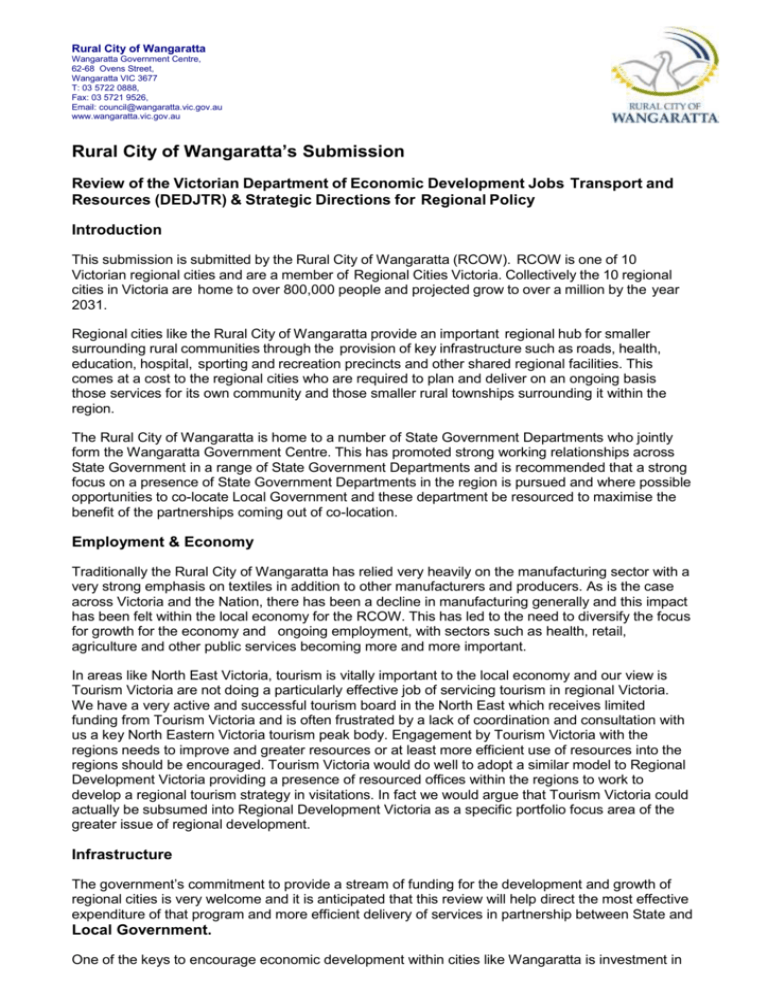
Rural City of Wangaratta Wangaratta Government Centre, 62-68 Ovens Street, Wangaratta VIC 3677 T: 03 5722 0888, Fax: 03 5721 9526, Email: council@wangaratta.vic.gov.au www.wangaratta.vic.gov.au Rural City of Wangaratta’s Submission Review of the Victorian Department of Economic Development Jobs Transport and Resources (DEDJTR) & Strategic Directions for Regional Policy Introduction This submission is submitted by the Rural City of Wangaratta (RCOW). RCOW is one of 10 Victorian regional cities and are a member of Regional Cities Victoria. Collectively the 10 regional cities in Victoria are home to over 800,000 people and projected grow to over a million by the year 2031. Regional cities like the Rural City of Wangaratta provide an important regional hub for smaller surrounding rural communities through the provision of key infrastructure such as roads, health, education, hospital, sporting and recreation precincts and other shared regional facilities. This comes at a cost to the regional cities who are required to plan and deliver on an ongoing basis those services for its own community and those smaller rural townships surrounding it within the region. The Rural City of Wangaratta is home to a number of State Government Departments who jointly form the Wangaratta Government Centre. This has promoted strong working relationships across State Government in a range of State Government Departments and is recommended that a strong focus on a presence of State Government Departments in the region is pursued and where possible opportunities to co-locate Local Government and these department be resourced to maximise the benefit of the partnerships coming out of co-location. Employment & Economy Traditionally the Rural City of Wangaratta has relied very heavily on the manufacturing sector with a very strong emphasis on textiles in addition to other manufacturers and producers. As is the case across Victoria and the Nation, there has been a decline in manufacturing generally and this impact has been felt within the local economy for the RCOW. This has led to the need to diversify the focus for growth for the economy and ongoing employment, with sectors such as health, retail, agriculture and other public services becoming more and more important. In areas like North East Victoria, tourism is vitally important to the local economy and our view is Tourism Victoria are not doing a particularly effective job of servicing tourism in regional Victoria. We have a very active and successful tourism board in the North East which receives limited funding from Tourism Victoria and is often frustrated by a lack of coordination and consultation with us a key North Eastern Victoria tourism peak body. Engagement by Tourism Victoria with the regions needs to improve and greater resources or at least more efficient use of resources into the regions should be encouraged. Tourism Victoria would do well to adopt a similar model to Regional Development Victoria providing a presence of resourced offices within the regions to work to develop a regional tourism strategy in visitations. In fact we would argue that Tourism Victoria could actually be subsumed into Regional Development Victoria as a specific portfolio focus area of the greater issue of regional development. Infrastructure The government’s commitment to provide a stream of funding for the development and growth of regional cities is very welcome and it is anticipated that this review will help direct the most effective expenditure of that program and more efficient delivery of services in partnership between State and Local Government. One of the keys to encourage economic development within cities like Wangaratta is investment in Rural City of Wangaratta Wangaratta Government Centre, 62-68 Ovens Street, Wangaratta VIC 3677 T: 03 5722 0888, Fax: 03 5721 9526, Email: council@wangaratta.vic.gov.au www.wangaratta.vic.gov.au infrastructure such as roads and drainage which are a major issue for us. Opportunities for investment in some of the more costly infrastructure makes broader development on both the commercial and domestic scale more affordable, therefore stimulating investment opportunities for housing and employment and growth in the local economy. Regional Development Victoria’s role in the delivery of these projects is very important and it is our view that this has been done quite successfully in the North East. Another critical piece of regional infrastructure in Wangaratta is the Airport which is currently well under-utilised but has the capacity to provide a local transport hub being very central to both the Hume Freeway, the Murray Valley Highway, the Melbourne-Sydney train line and as a regional airport. We have numerous enquiries looking for private investment opportunities to develop facilities on that site however development is somewhat limited at the moment due to inundation issues. We are currently working with the North East Catchment Management Authority to identify solutions to this. Cooperation from State Government Departments and a stream of infrastructure funding to enable this would be a good investment. Strategic Planning A great deal of work has also gone on within the Hume Region which the Rural City of Wangaratta is a partner in to develop the Hume Strategy and the Hume Regional Growth Plan. Good collaborative work has happened across Local Government, State Government and other authorities to establish regional priorities; however, the implementation of these regional priorities is often hampered by the absence of the funding beyond the initial strategy development to actually implement priority recommendations. Making these key regional strategies key criteria for significant funding would help more effectively and efficiently allocate whatever resources are available. Having said this, there needs to remain some flexibility for localised priorities on a Council by Council basis without reference to these broader regional strategies. Key Issues: Returning to the Rural City of Wangaratta specifically, some key points we would like to make are as follows: A range of State Government Departments as tenants of the Wangaratta Government Centre provides for very effective and efficient partnerships and a more streamlined delivery of strategies and projects. With the contraction of manufacturing, ongoing job attraction and retention is greatly assisted by the presence of these government services and we would argue the focus on this presence need to be maintained and where possible they should grow. The focus of Regional Development Victoria needs to maintain a very broad regional focus and vision, and not be too distracted or involved in smaller local issues, which are more likely the domain of local government. Funding programs through all departments including Regional Development Victoria need to have fast turnaround times with less steps and processes to go through, and a coordinated approach across government departments to ensure maximum effectiveness through leverage of a range of funds into more streamlined projects. One of the key focuses of this review should be to ensure that opportunities to leverage Local, State and Federal funding across the three levels of government are maintained and encouraged particularly for the development and implementation of regional priorities. Regional Development Victoria’s role could be further strengthened by providing greater autonomy to regional staff with the allocation of some discretionary funding, and greater Rural City of Wangaratta Wangaratta Government Centre, 62-68 Ovens Street, Wangaratta VIC 3677 T: 03 5722 0888, Fax: 03 5721 9526, Email: council@wangaratta.vic.gov.au www.wangaratta.vic.gov.au capacity to make policy decisions at the local level to achieve better outcomes more quickly in the regions (it is our view that sometimes the significance of local and regional issues get lost when they have to go to “head office” for decisions). Allocations to Sport and Recreation Victoria have been very low for a number of years with very little growth. This is an incredibly important program to rural and regional areas; greater allocations would encourage much better outcomes, help support greater health outcomes in rural and regional areas thus helping to reduce the growing cost of delivering health services across the regions. Regional Development Victoria’s role needs to be broader than just providing funding. Sufficient resources are required for them to be able to provide strong advice and support within the regions, encouraging business connections and collaborations, and brokerage with other departments and programs and philanthropic organisations should be encouraged. Finally, we support the strategic relocation of other agencies to regional areas such as the Transport Accident Commission, State Revenue Office, Rural Finance and the recent Vic Roads re-location proposal. We argue that elements of these relocations could be positioned in cities other than Bendigo, Ballarat and Geelong to encourage the government policy of growing the regions, which requires good job opportunities, supported by the development of high quality community infrastructure and housing opportunities. We would be happy to elaborate further on our submission and thank you for the opportunity. Yours sincerely Brendan McGrath Chief Executive Officer
